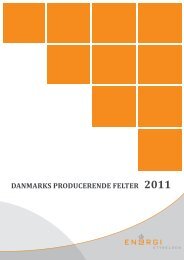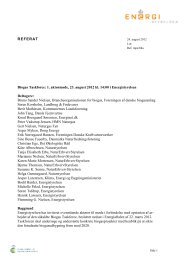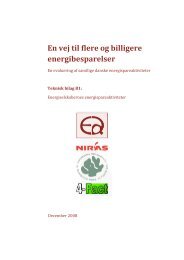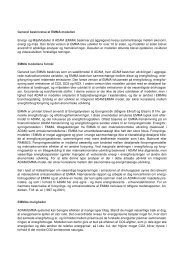Energy Strategy 2050 – from coal, oil and gas
Energy Strategy 2050 – from coal, oil and gas
Energy Strategy 2050 – from coal, oil and gas
Create successful ePaper yourself
Turn your PDF publications into a flip-book with our unique Google optimized e-Paper software.
Utilisation of bio<strong>gas</strong><br />
The natural <strong>gas</strong> grid <strong>and</strong> its associated storage facilities<br />
could also play a key role in an energy system without<br />
fossil fuels. This may be through utilising bio<strong>gas</strong> <strong>and</strong><br />
possibly other types of <strong>gas</strong> <strong>from</strong> organic sources. RE<br />
<strong>gas</strong>ses can be used at CHP plants in the same way as<br />
solid biomass <strong>and</strong> thereby they can act as a balance for<br />
the fluctuating electricity production <strong>from</strong> wind turbines.<br />
Photovoltaic solar modules <strong>and</strong><br />
wave power as supplements<br />
In the longer term, photovoltaic solar modules <strong>and</strong> wave<br />
power could replace some wind power. How much wind<br />
power they will replace will depend on technological development.<br />
Photovoltaic solar modules are a well tested<br />
technology, but at present they are more expensive than<br />
electricity <strong>from</strong> wind turbines. However, there may be<br />
technical <strong>and</strong> financial advantages in spreading electricity<br />
production between different technologies. Wave<br />
power is still at the developmental stage, but it may play<br />
a role in the long term.<br />
Spreading RE-based district<br />
heating <strong>and</strong> individual heating<br />
District heating systems make it possible to incorporate<br />
large amounts of fluctuating renewable energy at relatively<br />
low investment requirements. Continued exploitation<br />
<strong>and</strong> expansion of this infrastructure is an important<br />
element. There are strong indications of significant cost<br />
effectiveness potentials in converting <strong>from</strong> individual<br />
natural <strong>gas</strong> supply to district heating. The challenge is to<br />
find an appropriate cut-off between district heating <strong>and</strong><br />
individual heating in a technical <strong>and</strong> economic context.<br />
An intelligent energy system<br />
<strong>Energy</strong> production with significant amounts of fluctuating<br />
energy places pressure on the energy system to ensure<br />
that energy consumption can be covered hour by hour.<br />
Most important is exchange with foreign countries, <strong>and</strong><br />
this requires gradual expansion of transmission capacity.<br />
In addition, there is the need for more flexible (intelligent)<br />
electricity consumption so that electricity is used for heat<br />
pumps, electric b<strong>oil</strong>ers <strong>and</strong> to recharge electric cars, for<br />
example, when there are strong winds <strong>and</strong> normal electricity<br />
consumption is low. Finally, there will be a need for<br />
electricity storage capacity which can be supplied cost<br />
effectively by the Norwegian <strong>and</strong> Swedish hydropower<br />
facilities. However, it is possible that other types of electricity<br />
storage, for example based on battery technology,<br />
could in the future supplement foreign electricity trade.<br />
<strong>Energy</strong> <strong>Strategy</strong> <strong>2050</strong> <strong>–</strong> <strong>from</strong> <strong>coal</strong>, <strong>oil</strong> <strong>and</strong> <strong>gas</strong> to green energy.<br />
19

















